In the first days of Mountain Lakes, walking was the most common mode of transportation. Horse-drawn carriages had long since disappeared. People walked to and from the train station and to and from the stores. The trolley served for travel up and down the Boulevard and into Boonton or out to Bloomfield Avenue (now Route 46). Some people had automobiles but kept them in the city. A few of the more wealthy families owned automobiles and used them in Mountain Lakes as well. The pictures on these pages are enlargements of automobiles that appeared occasionally in the house photos. They are collected here so that they may be seen all together.
We who compiled these pictures are not knowledgeable about antique automobiles. However in April, 2001, we posted a note on an antique cars newsgroup (alt.autos.antique) asking for assistance in identifying these cars. We received many replies from all over the world. The descriptions that follow are compiled from those responses.
One thing we discovered quickly. It's very tough to identify most very old cars without seeing little identifying marks on them. Anyone who says "new cars all look the same" should look at 1920s cars!
The big problem with the really old cars is that styling wasn't really an art. Cars weren't all that common, or that reliable, and it was more important that your car start and run than it look good, or even unique. There were more than 5,000 different automobiles manufactured in the U. S. mostly in the east and midwest. Many companies, especially the smaller makers, either copied a lot of styling techniques or in some cases bought from common manufacturers when they were purchasing things like grilles, lights, or fenders.
Some of these cars might also have custom coachwork, which makes it tougher.
Keep in mind that a large number of the relatively inexpensive cars we take for granted today looked very huge and luxurious in the 1910s and 1920s -- Dodge, Chevrolet, Buick, etc. So one can't overlook a more common marque just because the car in the picture looks elaborate and luxurious.
Many states issued books listing the registration (license plate) numbers of each car in the state. These were accompanied with the name and address of the owner. If we could find one of these for New Jersey, we would have all the information needed to positively identify each car whose license plate is visible and its owner.
We would appreciate anyone reading this who knows the subject to send us comments. We would like to know the make and model of the cars we have not yet identified. E-mail your comments
There are several photos. Continue to scroll down until you have seen them all.
This auto is driving North on the Boulevard. It is in the photo of The trolley. Although some experts have asserted that this car is a Buick, probably around a 1908. others say no. They feel it looks awfully big to be a Buick, especially in the wheels. Also Buicks had their name in script across the radiator. The bottom line is we are still not sure what type of car this is. If anyone viewing this has any comments, please tell us.
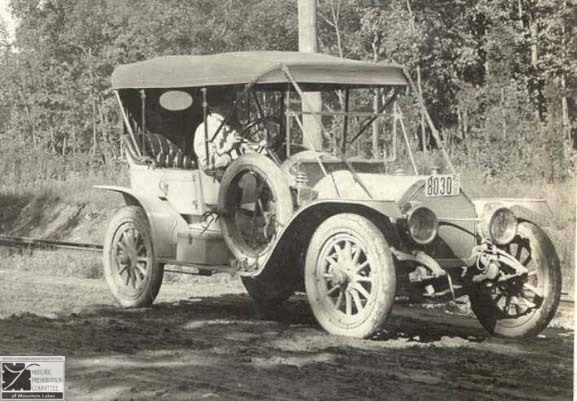
This is in the driveway of 50 Tower Hill Road. We were initially told this is an early Model T, circa 1908. However, subsequently this conclusion was disputed. The evidence is as follows.
The Model T Ford started with the 1909 model year. The first one was sold on October 1, 1908. The runabout (roadster) that was offered that year is similar to what is in the photo. The differences are these: The front axle on the Ford hung below the frame and had a single spring that ran from wheel to wheel perpendicular to the frame. This car appears to have semi-elliptical springs on the front. The Ford radiator was much shorter and ended at the front cross member of the frame. This one is long and extends to the front axle. The Ford radiator fill cap was small and on a short neck. This one is large and has a bail holding the top to the neck where the Ford screwed in. The headlights on the Ford were smaller and mounted higher than on this car. All of the side lights offered for the 1909 - 1914 Fords were square and had no handle on top. Here they are round with a handle. The Ford runabout had a third seat in the back as does this one, but the Ford's seat was small with a semi-circular (bucket) shape. This one is square, more a bench type, and it has a hand rail around it. There were only two top bows on the Model T. This car has an extra one leading forward. The spokes of the Ford steering wheel are bent to make the rim lower than the hub. It is the opposite on here. The Fords were left-hand drive. This car is right-hand drive. The rear brake drums were about half the size of those shown in this picture.
So we still don't know what it is. If anyone viewing this has any comments, please tell us.
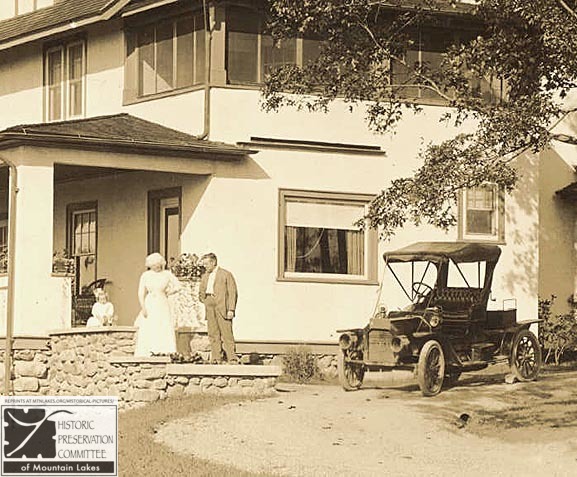
The picture below is in the driveway of 199 Boulevard. A former Mountain Lakes resident has said he's pretty sure this is a 1908 Packard Model 30. It's tough to say without a doubt as the photo is a bit blurry. But based on the front fenders, the rear tail lamp, the roof covering, windscreen and the outline of the drivers door area, he's 98% sure that is what it is.
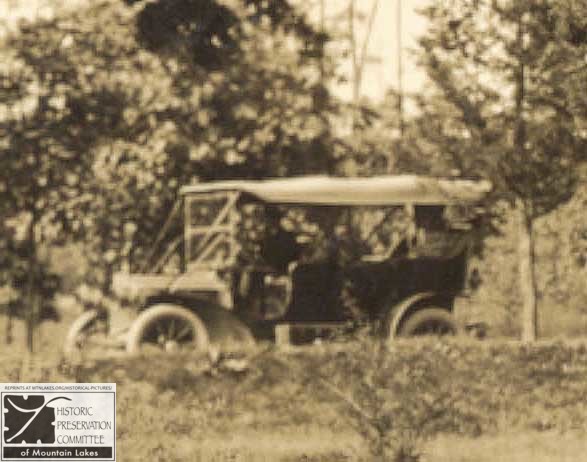
This car is driving on the Boulevard in the photo of 244 Boulevard.
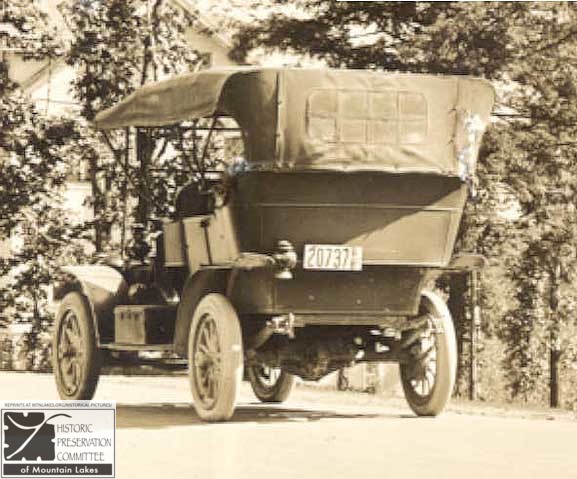
Little kids in an automobile in the side yard of 46 Dartmouth. The experts are pretty sure this is a Cadillac Model 30, probably a 1909. The radiator definitely looks Cadillac... but it wasn't uncommon for them to be copied. It also resembles a Buick, but the Buick had louvers in the side panels and this photo doesn't appear to have them so the consensus is it's a Cadillac. Most cars had front doors by 1912.
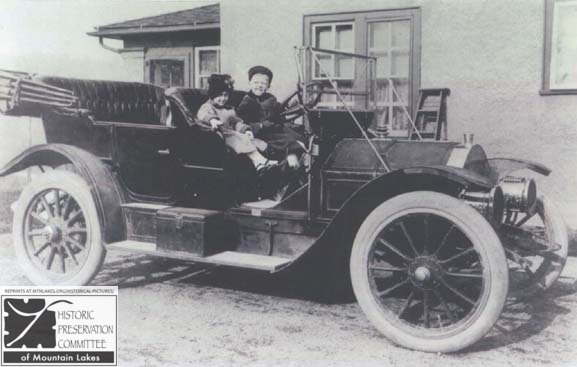
First Mountain Lakes Fire Engine. This is a mid-1920's Model TT Ford. TT designates the one-ton truck version of the famous Model T. The truck is a "Chemical Wagon" the two cylinders behind the seat contained a baking soda solution, when the truck got to the fire a bottle of acid in the sealed cylinder was broken. The chemical reaction produced the pressure to get the solution to the fire. There are also soda acid extinguishers behind the rear wheel. (This description is from John Cobo who is with the Firefighters Museum in Calgary).
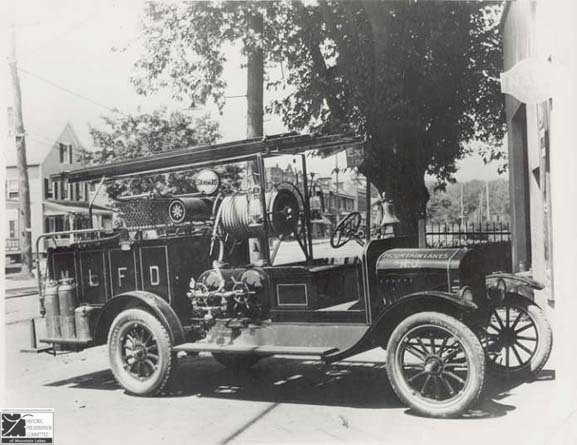
Police Chief Harry Dennis and an early Mountain Lakes police car and motorcycle.
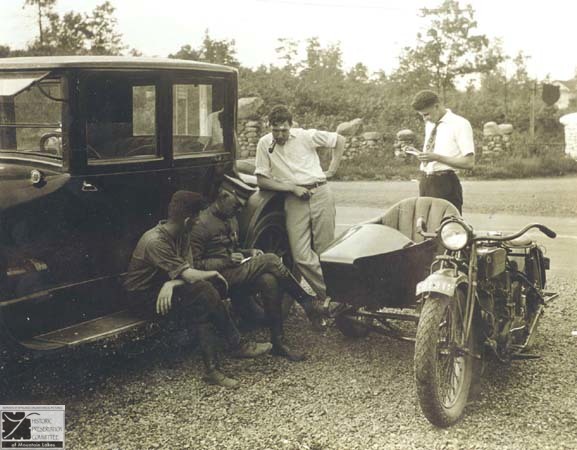
This car was parked in front of the Esplanade in 1911. An enlargement can be seen in the photo of the Esplanade Sign.
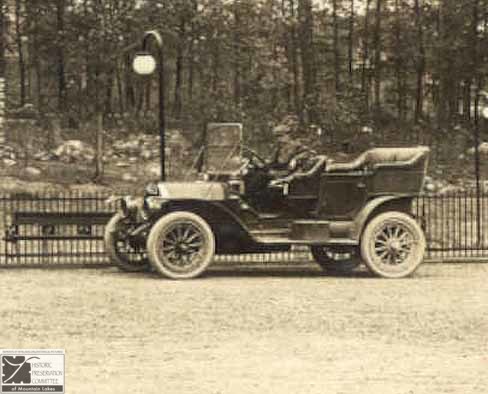
This auto was parked in front of the Midvale stores.
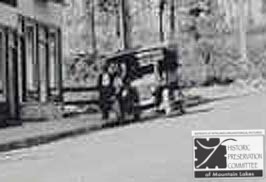
These two cars are in the picture 17 Briarcliff Road.
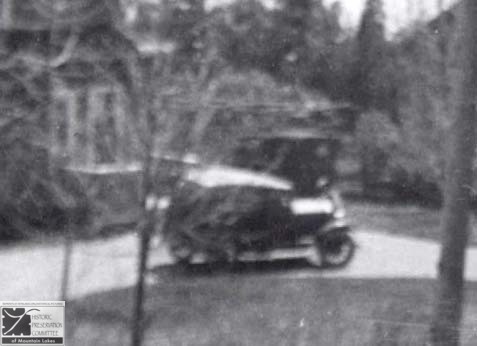
This car is in the garage at 157 Lake Drive. Although this photo isn't all that clear, this car is thought to be either a Packard or a Cadillac.
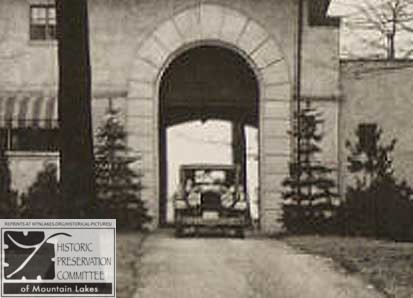
This is Colonel and Mrs Smith's car. This car is definitely an electric car, probably a Waverly Brougham Model 81 (1911). One thing is certain, it wouldn't take them far. The range of these electric cars was about 50 miles.
Nevertheless, electric vehicles had many advantages over their competitors in the early 1900s. They did not have the vibration, smell, and noise associated with gasoline cars. Changing gears on gasoline cars was the most difficult part of driving, while electric vehicles did not require gear changes. While steam-powered cars also had no gear shifting, they suffered from long start-up times of up to 45 minutes on cold mornings. The steam cars also had less range before needing water than an electric's range on a single charge. The only good roads of the period were in town, causing most travel to be local commuting, a perfect situation for electric vehicles, since their range was limited. The electric vehicle was the preferred choice of many because it did not require the manual effort to start, as with the hand crank on gasoline vehicles, and there was no wrestling with a gear shifter.
The lady is the wife of Maj. Clarence W. Smith. On the back of the original photo it says Col., so they may have promoted him before they sent him to France (WW I). It is not known whether he came back, or indeed whether he went at all. Mountain Lakes has no record of him after 1915. Col. And Mrs. Smith lived at 30 Dartmouth Road. Their Telephone Number was 319.
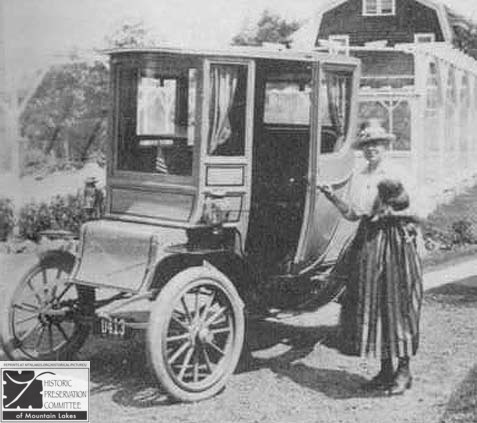
This car is in front of 17 Fernwood Place. This car looks like a Chevrolet, circa 1928.
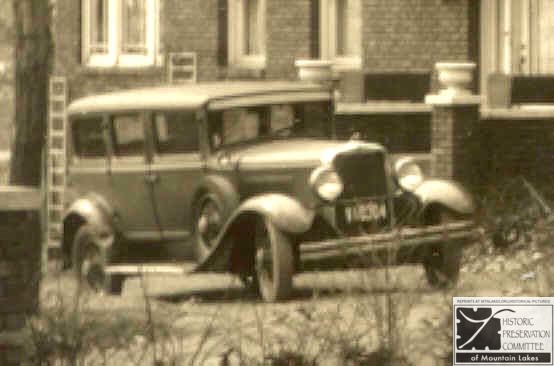
This car is in front of 1 Larchdell Way.
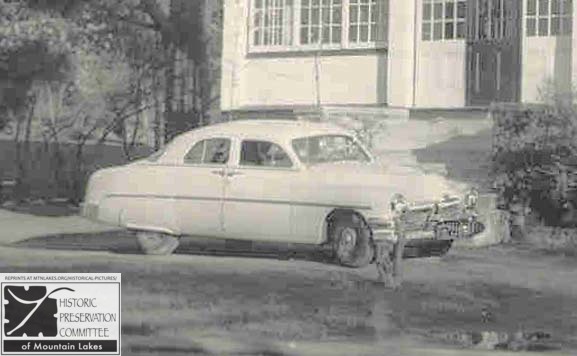
This photo was taken in the 1930's in front of the Community Church on Sunday. The third car in line is a 1930 Ford Model A Roadster.
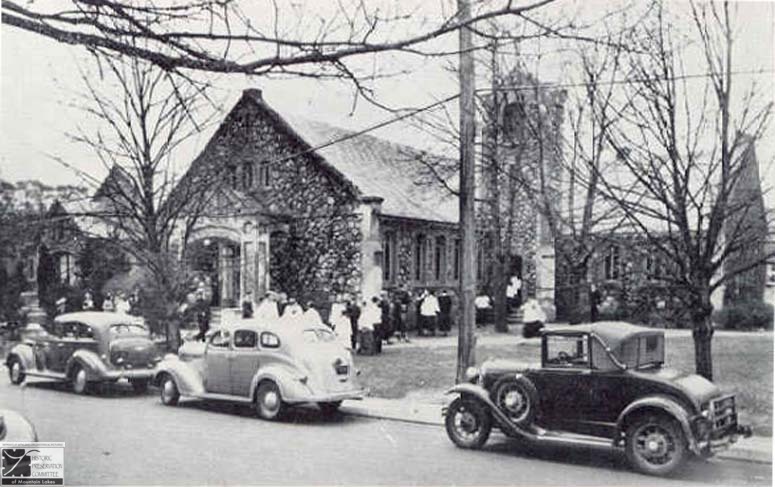
Information concerning reprints is available here.